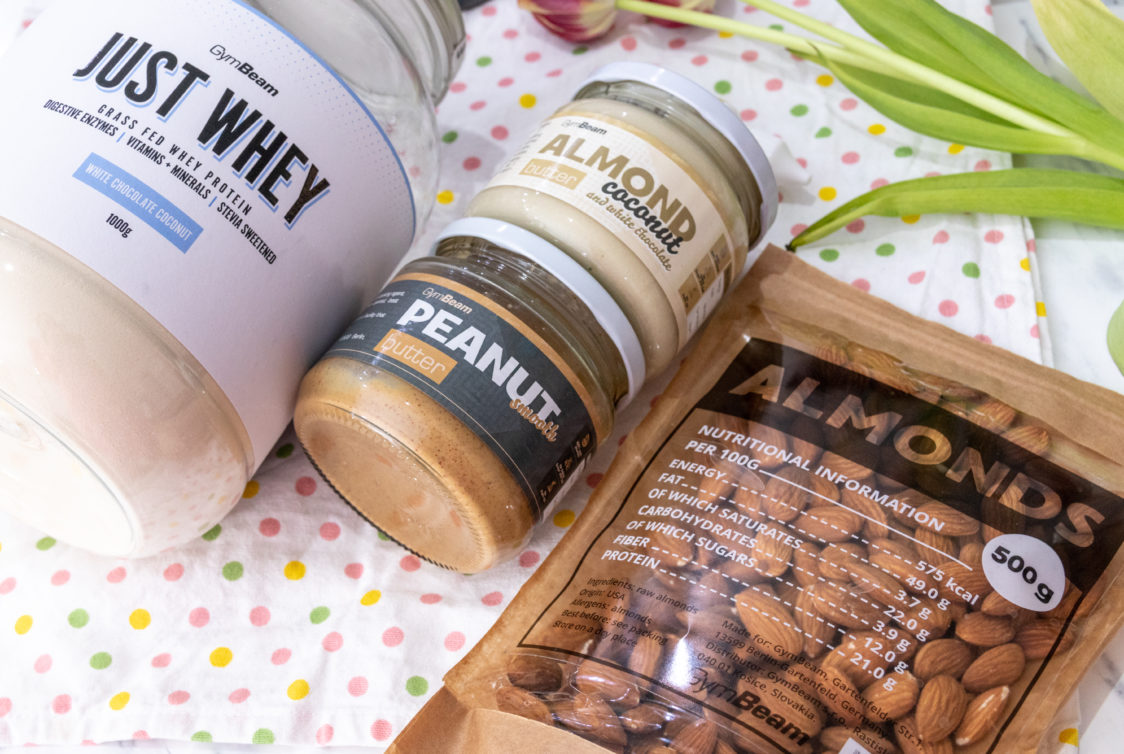Table of Contents
Proteins are contained in every cell in our body. They provide building materials for almost all cells of our organism. They are indispensable for muscles, bones, internal organs, hair and nails. In addition, they are a cornerstone for the formation of cells of the immune system. They are one of the three macronutrients that we need to take in optimal amounts every day. Our body does not create reserves of protein in the same way as it is in the case of fats or carbohydrates. Higher protein intake is especially important if you are trying to lose weight or gain muscle mass.
However, keeping up with protein intake is not always easy. The routine of the working week and a busy schedule can cause your diet and protein intake to get a little out of hand. A common problem is also the ignorance of how to compose the individual dishes that are part of a diet. As a result, you simply do not supply your body with the amount of protein it needs. This can then affect several aspects of your health, which will ultimately affect the capability of achieving your fitness goals. That’s why today, we bring you effective tips on how to get more protein into your diet and get all its benefits.
Benefits of protein consumption
Protein intake is primarily important for the growth and maintenance of healthy muscles, bones and tissues. In addition, it plays an important role in many biological processes. As we also said at the beginning, even the cells of the immune system cannot function properly without proteins. At the same time, it is indispensable for the proper functioning of the hormonal system and enzymatic reactions. [5]
Other benefits of consuming protein include:
- Metabolic acceleration – this is thanks to the thermal effect (TEF) of proteins, which is much higher than in the case of carbohydrates and fats. The thermal effect represents the energy needed for nutrient metabolism. Its amount varies from one macronutrient to another. The TEF value for carbohydrates is equal to 5-10%. However, the more accurate number depends on their type. For fats, it is 0 – 3% and for proteins up to 20 – 30% of their total energy content. In practice, this means that, for example, at 100 kcal taken in the form of proteins, your body will actually use about 70 – 80 kcal. In the case of a daily protein intake of 150 g, you can burn an extra 180 kcal per day. [6–7]
- Lowering blood pressure – High blood pressure is a major cause of heart attacks, strokes and chronic kidney disease. Some positive effect of proteins on its reduction is also indicated by several studies, which refer mainly to vegetable proteins. [11]
- Boosting regeneration after exercise or injury – protein is the main building block of your tissues and organs. Numerous studies show that consuming protein in optimal amounts can contribute to faster regeneration. [8–9]
- Reduced appetite – as a result of being the most filling of the three macronutrients. Thanks to that, you eat smaller portions of food with a higher protein content and, in addition, it can postpone the feeling of hunger. [6] [10]

The amount of recommended protein intake
So if you know all the benefits of consuming protein, it’s time to look at its adequate intake. But how much protein is enough? It depends on several factors, such as gender, lifestyle, fitness goals, weight, and your current level of physical activity. [1]
The minimum protein intake should not to fall below 0.8 g per kilogram body weight (BW). However, this small amount is only relevant to people who live a more sedentary lifestyle. For others, this amount seems to be insufficient, and for more active people, a range of 1.2-1.8 g / kg BW is most recommended. For strength athletes, this value moves even further to the range of 1.4–2 g / kg BW. However, even this number may not be final and the recommended protein intake may be higher, especially during a very demanding training period and the effort to lose weight or gain muscle. [2–4]
Learn more about the optimal protein intake in the article When and How Much Protein to Take for Maximum Results?
Tips on how to get more protein into your diet
The fact is that getting more protein into our diet is not rocket science. It doesn’t even take that much time or effort. Below you can find some tips to help you.
1. Pay attention to the protein content in each meal
In the case of protein, it is not only the total amount that you eat that matters, but also the amount represented in each meal. Moreover, this should also include a balanced ratio of all macronutrients, i.e. not only proteins but also carbohydrates and fats. For protein, several studies recommend having about 20-30 grams per serving. If this amount is contained in each of your 5 meals a day and corresponds to your optimal daily protein intake, it can help you better build and maintain muscle mass. Another study then recommends a maximum dose of protein when building muscle mass to be at 0.55 g / kg / meal. For a 70 kg individual, it would be 38.5 g of protein, at least four meals a day. [12–13] [23]
You might be interested in these products:
Where is protein typically missing and how to supplement it?
Many commonly consumed foods may lack the required amount of protein. These are mainly oatmeal, vegetable salads, sweet desserts or snacks. However, each of them can be effectively improved and enriched with the required dose of protein. How to do it? It is actually quite simple:
- You can add protein to your cereal or oatmeal.
- Vegetable salad can be upgraded by, for example, adding chicken, mozzarella, tuna or sardines.
- A decent content of protein is usually missing in sweet foods, such as popular pancakes. There also exist protein pancakes mix, which you can also use to prepare delicious waffles. You will get up to 20.5 g of protein in one serving of such pancakes. Another solution may be to add a dairy product such as Skyr, 0% Fat Greek yogurt or cottage cheese.
- You can also prepare pastries, cakes and similar goodies just as effectively. Just add protein to the dough and you can easily increase their protein content by up to 30 grams. The same goes for smoothies, where again, you can just simply add some suitable dairy product.
Thanks to these tips, you will get a much more balanced and complex meal that will satisfy you and reliably provide all the necessary nutrients. If you want to learn more about such a diet and find out what the ideal nutritional value of food is, be sure to read our article What Is a Healthy Diet and How to Learn To Eat Healthy?

2. Reach for quick snacks loaded with protein
Snacks are a great way to add more protein to your diet. Of course, I don’t mean classic chips, crackers or sweets. Their nutritional value is usually overtaken by fats and sugars, with a minimal dose of protein. In addition, such goodies are high in calories. So, when talking about snacks, we mean their healthier alternatives. Fortunately, today, we live in a time when our dining options are more varied than ever.
Protein chips can perfectly replace their fried potato alternative. They have a balanced nutritional composition, a high proportion of fibre and contain quality pea protein. However, you will also find a higher amount of calories in them, so you should consume them in a reasonable amount and within your balanced diet. If you have a sweet tooth and love chocolate, even then there is a solution for you. It is a delicious Fitcheat Protein Chocolate, which contains up to 21.6 g of protein and 10 times lower sugar content than the classic average chocolate. Moreover, other very popular snacks rich in protein include protein bars, milkshakes, beef jerky or cookies. Their great advantage is that you can have them at hand at any time and enjoy your dose of protein at university or at work. If you add some fruit, you will get an ideal and nutritiously rich snack, which is also convenient when going for trips.

3. Eat more dairy products naturally rich in protein
Dairy products are generally an excellent source of protein. They also contain many other important nutrients like calcium and vitamin D. In addition, according to a 2015 study, dairy products could help when losing weight. This is because they increase the concentration of peptides (GLP-1 and PYY). They signal a feeling of satiety to the brain and, among other things, also help slow down gastric emptying. [14]
Popular sources of dairy protein include:
- Semi-skimmed milk 1.5% (approx. 3.3 g protein / 100 ml)
- 0% Fat Greek yogurt (approx. 10 g protein / 100 g)
- Edam cheese 30% (approx. 27 g protein / 100 g)
- Sheep cheese (approx. 17 g protein / 100 g)
- Skyr (approx. 12 g protein / 100 g)
- Light cottage cheese (approx. 12 g protein / 100 g)
- Cottage (approx. 12 g protein / 100 g)
4. Enjoy a protein shake
The protein shake is a very fast and convenient way to get more protein into your diet. It will help you meet your daily intake and you can consume it at any time during the day. All you have to do is mix your favourite flavour with water or milk and a delicious drink is ready. One serving of average whey protein can offer you about 20 g of protein (about 120 kcal). However, the more precise amount depends on the particular type of protein. If you have more time and want to enrich the nutritional profile of your protein shake, try adding some peanut butter, Greek yogurt, chia seeds or various fruits. After mixing these ingredients, your resulting drink will not only get a better taste, but also more protein and valuable extra nutrients.
If you supplement your breakfast with a protein shake, you can get some additional protein and increase your feeling of satiety. However, its use is ideal after finishing your training. Consumption of 20-25 g of protein just after exercise helps with faster regeneration of the muscle mass damaged by training. However, it is important to ensure that your total daily protein intake is optimal. [15–16]

Casein protein is also a popular way to increase protein intake. Its natural source is cow’s milk. Casein makes up about 80% of the total protein in milk and the remaining 20% is whey. It is most often found in the form of micellar casein. Its main advantage is the slow absorption and gradual release of amino acids, which makes it a popular night-time supplement. However, it will also be great for longer periods without food during the day. If you choose to consume it in the evening, it will provide your body with a constant supply of amino acids throughout the night and can thus support the growth or regeneration of muscle mass. [22]
5. Reach for animal protein sources
Animal protein is still amongst the best ones out there. Its best source is meat, which can offer you a high protein content with an ideal spectrum of essential amino acids. However, the specific values depend on the type of meat itself. It is ideal to choose a skinny one that does not contain unnecessary amount of fat. These are, for example, chicken and turkey breasts, rabbits or lean beef. Fish, which also contain high amounts of healthy fats, are also an excellent source of protein.
Healthy fats also support the immune system, improve brain function and can affect blood pressure or cholesterol levels. In terms of protein content, tuna stands out among fish in particular, offering up to 24 g protein / 100 g. It can be prepared in many different ways, for example, a quick salad with tuna, cashew nuts and calorie-free sauce. Egg whites with a content of 10 g protein / 100 g can also be a good source of animal protein and healthy fats. Instead of eating whole eggs, you can use them, for example, in our delicious recipes, which you will find in the article Three Egg Recipes for Breakfast Eggs for Breakfast in Three Different Ways.
For tasty inspiration on how to use animal types of protein, be sure to visit our fitness recipes section.
6. Exchange ordinary bread or pasta for whole grain alternatives and give pseudocereals a chance
Whole grain foods contain more important nutrients, including fibre, vitamins, minerals and antioxidants, than their refined versions. In addition, they can effectively help you increase your protein intake. For example, a pseudocereal quinoa contains 14 g protein / 100 g. It can be prepared as a side dish instead of rice, which has about 10 g less protein. However, quinoa is also suitable for various salads, savoury or sweet desserts. [17]
The key is to give preference to whole-grain foods over their refined versions. It can be pasta, bulgur, couscous, spaghetti or rice. Buckwheat, amaranth or wild rice are also suitable. Wholemeal bread, which often has a surprisingly high content of plant proteins, also deserves a mention. One 43-gram slice of wholemeal bread can contain up to 5 grams of protein. [18]
7. Try legumes and snack on nuts
Legumes are a very good choice to increase protein intake. These include all kinds of beans, lentils and soya. In addition to offering you quality protein, they are also a great source of fibre, which is beneficial for healthy digestion. Together with complex carbohydrates, they can fill you up for a long time and have a high content of antioxidants. Consumption of legumes is associated with lowering LDL cholesterol and reducing the risk of heart disease. [19 – 20]
Popular types of legumes include:
- red beans (approx. 23 g protein / 100 g)
- red lentils (approx. 24 g protein / 100 g)
- chickpeas (approx. 19 g protein / 100 g)
- green peas (approx. 23 g protein / 100 g)
- mung bean (approx. 23 g protein / 100 g)
You can prepare traditional Mexican chilli con carne or a quick breakfast burrito from red beans. If you prefer lighter meals, try lentil salad with roasted carrots, avocados and feta cheese. For chickpeas lovers, we recommend vegan curry.
You can also eat nuts for a snack. Almonds, cashews and pistachios are great as they can replace processed or sweet foods. They have a delicious taste and in addition to fibre, they are a great source of protein. Specifically, pistachios are 21 g / 100 g, cashews contain 18 g / 100 g and in almonds you will find 21 g protein / 100 g. Nut butters, which offer a wide range of uses in the kitchen, are also definitely worth paying attention to. You can find inspiration for their use in our article 5 Fitness Recipes for Lovers of Nuts and Nut Butters. However, when consuming them, it is necessary to remember about the relatively high content of calories and include them as part of a balanced diet.

8. Try plant-based meat alternatives
Plant-based meat alternatives are very popular amongst vegans and vegetarians. However, you can give them a shot even if you prefer classic meat. You will taste something new whilst being provided with all the necessary nutrients, including a rich portion of protein. [21]
One of the best-known plant-based meat substitutes is seitan, which is made from gluten. Unlike soy, it resembles real meat in its appearance and texture. It has a high protein content (up to 13 g / 100 g) and a low fat content. You can fry, roast or even grill it. Therefore, it can be very easily incorporated into various recipes. Another vegetable alternative to meat is tofu, which, in BIO quality, has 7.2 g of protein / 100 g and BIO tempeh with 17.8 g of protein / 100 g. The excellent recipes for crunchy tofu steaks, sweet potatoes with tofu and cashew dressing or tofu protein cheesecake are definitely worth having a look at.
If you are more interested in this topic, be sure not visit our article Plant Alternatives to Meat: Which Are the Best, How Much Protein They Contain and Can They Completely Replace Meat?
Conclusion
The fast-paced lifestyle often interferes with our eating habits. This is then reflected in the total protein intake, which in many cases may not be ideal. However, as you just read above, smuggling it into a fairly normal diet may not be as difficult as you initially thought. Just pay attention to every meal of your day so that all your portions contain a balanced amount of protein. In addition, you can use tasty, protein-packed snacks on the go, at work or at university, which will also satisfy you perfectly.
What is your daily protein intake? Do you try to include it in every meal, or do you need to try harder? If you liked the article, don’t hesitate to share it so that your friends can also find out how to enrich their diet with the optimal amount of protein.
[1] Neil Hill - 6 FACTORS THAT AFFECT YOUR PROTEIN REQUIREMENTS – https://www.muscleandfitness.com/flexonline/flex-nutrition/6-factors-affect-your-protein-requirements/
[2] Optimal Protein Intake Guide – https://examine.com/guides/protein-intake/#how-much-protein-do-you-need-per-day
[3] Dietary Reference Intakes for Energy, Carbohydrate, Fiber, Fat, Fatty Acids, Cholesterol, Protein, and Amino Acids – https://www.nap.edu/read/10490/chapter/1
[4] Ralf Jäger, Chad M. Kerksick, Bill I. Campbell, Paul J. Cribb, Shawn D. Wells, Tim M. Skwiat - International Society of Sports Nutrition Position Stand: protein and exercise – https://jissn.biomedcentral.com/articles/10.1186/s12970-017-0177-8
[5] Yvette Brazier - How much protein does a person need? – https://www.medicalnewstoday.com/articles/196279
[6] Thomas L Halton, Frank B Hu - The effects of high protein diets on thermogenesis, satiety and weight loss: a critical review – https://pubmed.ncbi.nlm.nih.gov/15466943/
[7] Carol S Johnston, Carol S Day, Pamela D Swan - Postprandial thermogenesis is increased 100% on a high-protein, low-fat diet versus a high-carbohydrate, low-fat diet in healthy, young women – https://pubmed.ncbi.nlm.nih.gov/11838888/
[8] David Frankenfield - Energy expenditure and protein requirements after traumatic injury – https://pubmed.ncbi.nlm.nih.gov/16998142/
[9] L. Russell - The importance of patients' nutritional status in wound healing – https://pubmed.ncbi.nlm.nih.gov/12070399/
[10] Wendy A M Blom, Anne Lluch, Annette Stafleu, Sophie Vinoy, Jens J Holst, Gertjan Schaafsma, Henk F J Hendriks - Effect of a high-protein breakfast on the postprandial ghrelin response – https://pubmed.ncbi.nlm.nih.gov/16469977/
[11] Wieke Altorf-van der Kuil, Mariëlle F Engberink, Elizabeth J Brink, Marleen A van Baak - Dietary protein and blood pressure: a systematic review – https://pubmed.ncbi.nlm.nih.gov/20711407/
[12] Heather J Leidy, Peter M Clifton, Arne Astrup, Thomas P Wycherley - The role of protein in weight loss and maintenance – https://pubmed.ncbi.nlm.nih.gov/25926512/
[13] Donald K Layman, Tracy G Anthony, Blake B Rasmussen, Sean H Adams, Christopher J Lynch, Grant D Brinkworth, Teresa A Davis - Defining meal requirements for protein to optimize metabolic roles of amino acids – https://pubmed.ncbi.nlm.nih.gov/25926513/
[14] Angelo Tremblay, Caroline Doyon, Marina Sanchez - Impact of yogurt on appetite control, energy balance, and body composition – https://academic.oup.com/nutritionreviews/article/73/suppl_1/23/1819066
[15] Tyler A Churchward-Venne, Nicholas A Burd & Stuart M Phillips- Nutritional regulation of muscle protein synthesis with resistance exercise: strategies to enhance anabolism – https://nutritionandmetabolism.biomedcentral.com/articles/10.1186/1743-7075-9-40
[16] Chad M. Kerksick, Shawn Arent, Brad J. Schoenfeld, Jeffrey R. Stout, Bill Campbell, Colin D. Wilborn - International society of sports nutrition position stand: nutrient timing – https://www.ncbi.nlm.nih.gov/pmc/articles/PMC5596471/
[17] Marc P. McRae - Health Benefits of Dietary Whole Grains: An Umbrella Review of Meta-analyses – https://www.ncbi.nlm.nih.gov/pmc/articles/PMC5310957/
[18] Sarah Garone - Whole Wheat Bread Nutrition Facts and Health Benefits – https://www.verywellfit.com/whole-wheat-bread-nutrition-facts-and-health-benefits-5069803
[19] Prasanth Surampudi, Byambaa Enkhmaa, Erdembileg Anuurad, Lars Berglund - Lipid Lowering with Soluble Dietary Fiber – https://pubmed.ncbi.nlm.nih.gov/27807734/
[20] Lydia A. Bazzano, Jiang He, Lorraine G. Ogden - Legume Consumption and Risk of Coronary Heart Disease in US Men and Women – https://jamanetwork.com/journals/jamainternalmedicine/fullarticle/649612
[21] Winston J Craig, Ann Reed Mangels, American Dietetic Association - Position of the American Dietetic Association: vegetarian diets – https://pubmed.ncbi.nlm.nih.gov/19562864/
[22] Jorn Trommelen, Imre W K Kouw, Andrew M Holwerda, Tim Snijders, Shona L Halson, Ian Rollo, Lex B Verdijk, Luc J C van Loon - Presleep dietary protein-derived amino acids are incorporated in myofibrillar protein during postexercise overnight recovery – https://pubmed.ncbi.nlm.nih.gov/28536184/
[23] Brad Jon Schoenfeld, Alan Albert Aragon - How much protein can the body use in a single meal for muscle-building? Implications for daily protein distribution – https://jissn.biomedcentral.com/articles/10.1186/s12970-018-0215-1

